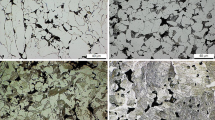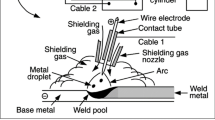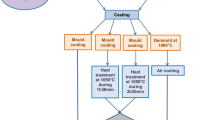Abstract
Experimental modeling of the technology for producing a matrix by sintering a diamond-containing briquette with a filler consisting of tungsten monocarbide powder impregnated with a Fe–C eutectic melt in vacuum is performed in this work. The microstructure and elemental and phase compositions of the products formed in the process of sintering of the diamond-containing matrix with impregnation with a Fe–C eutectic melt in vacuum are studied by scanning electron microscopy, X-ray microanalysis, X-ray phase analysis, and Raman spectroscopy. It is found that the matrix consists of 61.0% tungsten carbide, 17.0% iron carbide, 16.5% α-Fe, and 5.5% graphite phases. The Fe–C alloy eutectic that acts as a matrix binder consists of a ferrite–pearlite metal base with inclusions of graphite. It is shown that, at the diamond–matrix interface, the graphite inclusions are formed not as a continuous layer but as discontinuous areas along the perimeter of the diamond grains. The microhardness of the WC-based matrix with impregnation with a Fe–C melt is ~11 GPa, which by more than three exceeds the microhardness of a WC–Co–Cu hard-alloy matrix obtained by sintering with impregnation with copper. The obtained results can be used in the development of production technology of wear-resistant matrices for a wide variety of diamond tools used in the processing of materials with a high level of hardness.





Similar content being viewed by others
REFERENCES
Bakul’, V.N., Nikitin, Yu.I., Vernik, E.B., and Selekh, V.F., Osnovy proektirovaniya i tekhnologiya izgotovleniya abrazivnogo i almaznogo instrumenta (Fundamentals of Design and Manufacturing Technology of Abrasive and Diamond Tools), Moscow: Mashinostroenie, 1975.
Novikov, N.V., Bondarenko, N.A., Zhukovskii, A.N., and Mechnik, V.A., The effect of diffusion and chemical reactions on the structure and properties of drill bit inserts. 1. Kinetic description of systems Cdiamond–VK6 and Cdiamond–(VK6–CrB2–W2B5), Fiz. Mezomekh., 2005, vol. 8, no. 2, pp. 99–106.
Novikov, N.V., Bondarenko, N.A., Zhukovskii, A.N., and Mechnik, V.A., The effect of diffusion and chemical reactions on the structure and properties of drill bit inserts. 2. Evaluation results for the structural state of superhard materials of composition diamond–hard alloy VK6, Fiz. Mezomekh., 2006, vol. 9, no. 2, pp. 107–116.
Vityaz’, P.A., Zhornik, V.I., and Kukareko, V.A., A research of structural-phase state and properties of sintered alloys modified by nano-sized diamond containing additives, Izv. Nats. Akad. Nauk Belarusi, Ser. Fiz.-Tekh. Nauk, 2011, no. 3, pp. 5–17.
Artini, C., Muolo, M.L., and Passerone, A., Diamond–metal interfaces in cutting tools: A review, J. Mater. Sci., 2012, vol. 47, no. 7, pp. 3252–3264.
Semenov, A.P., Pozdnyakov, V.V., and Kraposhina, L.B., Trenie i kontaktnoe vzaimodeistvie grafita i almaza s metallami i splavami (Friction and Contact Interaction of Graphite and Diamond with Metals and Alloys), Moscow: Nauka, 1974.
Semenov, A.P., Pozdnyakov, V.V., and Lapshina, V.A., Contact eutectic melting of diamond and graphite in the contact with metals of iron triad, Dokl. Akad. Nauk USSR, 1968, vol. 181, no. 6, pp. 1368–1371.
Nozhkina, A.V., Bugakov, V.I., and Laptev, A.I., Strength of diamond materials after heating under pressure, Porodorazrush. Metalloobr. Instrum. – Tekh. Tekhnol. Ego Izgotovl. Primenen., 2018, no. 21, pp. 151–160.
Gurevich, Yu.G., Theory of eutectic alloys and eutectic (contact) melting, Met. Sci. Heat Treat., 2010, vol. 52, pp. 354–356. https://doi.org/10.1007/s11041-010-9281-y
Zalkin, V.M. and Kraposhin, V.S., Structure of iron-carbon melts. About stability of cementite in melts, Met. Sci. Heat Treat., 2010, vol. 52, pp. 3–6. https://doi.org/10.1007/s11041-010-9221-x
Pant, U., Meena, H., and Shivagan, D.D., Development and realization of iron-carbon eutectic fixed point at NPLI, MAPAN, 2018, vol. 33, pp. 201–208.
Kolesnichenko, G.A., Naidich, Yu.V., Petrischev, V.Ya., and Sergeenkova, V.M., Kinetics of contact melting in iron-carbon systems, Powder Metall. Met. Ceram., 1996, vol. 35, nos. 9–10, pp. 529–532.
Chumanov, I.V. and Anikeev, A.N., Impregnation of tungsten-carbide substrates with low-carbon steel, Steel Transl., 2018, vol. 48, no. 5, pp. 296–300. https://doi.org/10.3103/S0967091218050029
Anikeev, A.N., Chumanov, V.I., and Chumanov, I.V., Study of wettability of wc with iron melt by different methods, Vestn. Yuzh.-Ural. Gos. Univ., Ser. Metall., 2013, vol. 13, no. 2, pp. 44–46.
Tikhomirov, S.V. and Kimstach, T.B., Spectroscopy of Raman scattering is a promising method for the investigation of carbon nanomaterials, Analitika, 2011, no. 1, pp. 28–32.
Bukalov, S.S., Mikhalitsin, L.A., Zubavichus, Ya.V., Leites, L.A., and Novikov, Yu.N., Investigation of the structure of graphite and some other sp2 carbon materials by means of Raman microspectrometry and X-ray diffraction, Ross. Khim. Zh., 2006, vol. 50, no. 1, pp. 83–91.
Sidorenko, D.A., Zaitsev, A.A., Kirichenko, A.N., Levashov, V.V., Kurbatkina, V.V., Loginov, P.A., Rupasov, S.I., and Andreev, V.A., Interaction of diamond grains with nanosized alloying agents in metal-matrix composites as studied by Raman spectroscopy, Diamond Relat. Mater., 2013, vol. 38, pp. 59–62. https://doi.org/10.1016/j.diamond.2013.05.007
Ni, Z., Wang, Y., Yu, T., and Shen, Z., Raman spectroscopy and imaging of graphene, Nano Res., 2008, vol. 1, no. 4, pp. 273–291. https://doi.org/10.1007/s12274-008-8036-1
Ferrari, A.C., Meyer, J.C., Scardaci, V., Casiraghi, C., Lazzeri, M., Mauri, F., Piscanec, S., Jiang, D., Novoselov, K.S., Roth, S., and Geim, A.K., Raman spectrum of graphene and graphene layers, Phys. Rev. Lett., 2006, vol. 97, art. ID 187401. https://doi.org/10.1103/PhysRevLett.97.187401
Yoon, D., Moon, H., Son, Y.-W., Choi, J.S., Park, B.H., Cha, Y.H., Kim, Y.D., and Cheong, H., Interference effect on Raman spectrum of graphene on SiO2/Si, Phys. Rev. B, 2009, vol. 80, art. ID 125422. https://doi.org/10.1103/PhysRevB.80.125422
Nozhkina, A.V., The influence of metals on the phase transformation of diamond to graphite, Sverkhtverd. Mater., 1988, no. 3, pp. 11–15.
Sidorenko, D.A., Levashov, E.A., Loginov, P.A., Svyndina, N.V., Skryleva, E.A., and Uskova, I.E., A mechanism of spontaneous diamond cladding with tungsten carbide in the course of tool sintering with the Cu–Fe–Co–Ni nanomodified metallic binder, Izv. Vyssh. Uchebn. Zaved., Tsvetn. Metall., 2015, no. 5, pp. 53–63. https://doi.org/10.17073/0021-3438-2015-5-53-63
Author information
Authors and Affiliations
Corresponding authors
Additional information
Translated by E. Boltukhina
Rights and permissions
About this article
Cite this article
Sharin, P.P., Akimova, M.P., Yakovleva, S.P. et al. The Structure and Microhardness of Binding for Diamond Tools Based on Tungsten Carbide Obtained by Impregnation with an Iron–Carbon Melt. Inorg. Mater. Appl. Res. 12, 1562–1571 (2021). https://doi.org/10.1134/S2075113321060228
Received:
Revised:
Accepted:
Published:
Issue Date:
DOI: https://doi.org/10.1134/S2075113321060228




